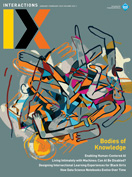Authors:
Morten Hertzum, Torkil Clemmensen, Pedro F. Campos, Barbara Rita Barricelli, Carl Emil Derby Hansen, Linnea K. Herbæk, Jose Abdelnour-Nocera, Arminda Guerra Lopes, Parisa Saadati
Over the preceding decades, usability testing became widely used for revealing design problems in information systems while they are still at the prototype stage. Normally, these tests involve removing users from their work for an hour or two to have them solve preset tasks with a system prototype in a lab-like setting. As a result, usability testing is insensitive to many of the organizational and contextual issues that determine the fit between a system and its real-world environment. Methods such as work domain analysis and scenario-based design aim to address this limitation but from an analysis-and-design perspective. In contrast,…
You must be a member of SIGCHI, a subscriber to ACM's Digital Library, or an interactions subscriber to read the full text of this article.
GET ACCESS
Join ACM SIGCHIIn addition to all of the professional benefits of being a SIGCHI member, members get full access to interactions online content and receive the print version of the magazine bimonthly.
Subscribe to the ACM Digital Library
Get access to all interactions content online and the entire archive of ACM publications dating back to 1954. (Please check with your institution to see if it already has a subscription.)
Subscribe to interactions
Get full access to interactions online content and receive the print version of the magazine bimonthly.






